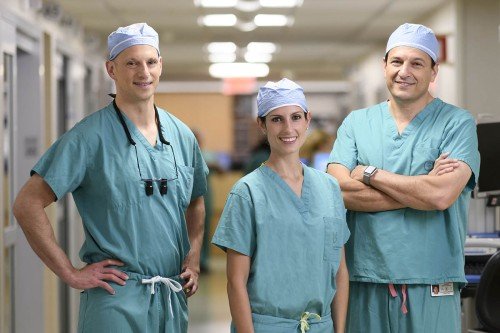Lymphedema is swelling in the arm or hand and sometimes in the breast or chest wall that can be very uncomfortable.
It can occur when some or all of the axillary (underarm) lymph nodes are removed as part of treatment for breast cancer. It can also happen after the axillary lymph nodes have received radiation. In both instances, the lymphatic fluid that’s normally filtered from the tissue collects and causes swelling.
Signs of lymphedema include:
- visible swelling in the arm, hand, breast, or chest wall
- a sensation of heaviness, achiness, or tightness in the arm
- easy fatigue of the arm
- pain in the arm
If you’re experiencing lymphedema after breast cancer surgery or radiation therapy, the experts at Memorial Sloan Kettering recommend prompt treatment. For many women, lymphedema therapy can be very helpful. It’s important to note that there is no known cure for lymphedema at this time. However, the methods we describe here may help ease symptoms. MSK’s researchers are trying to find ways to both prevent and cure this painful condition.
Lymphedema Screening and Prevention Program
MSK has a special screening and prevention program for people at high risk of developing lymphedema. Our program was created by nurse practitioners (NPs) with deep experience in caring for people with lymphedema.
MSK’s program identifies people who are most likely to get this condition. When we start treatment early, we can improve the quality of life of people with lymphedema.
How does this program work?
Our nurse practitioners prevent and manage lymphedema through:
- A personal assessment.
- Diagnostic procedures, such as an indocyanine green (ICG) lymphography scan, to find early changes after breast cancer surgery.
- Coordinating your care across a team of different healthcare providers.
Your NPs also may refer you to a research study, also known as a clinical trial, about lymphedema. MSK is a leader in lymphedema research.
Assessment and screening for lymphedema
Many people do not know the warning signs of lymphedema. Black and Hispanic people have the highest risk of developing lymphedema. Our NPs will assess your health history and cancer treatments to find out your risk for lymphedema. They can make a screening plan for you and refer you for treatment.
Treatment for lymphedema
Treatment can include lymphedema therapy with MSK’s physical and occupational therapists. If surgery is best for you, MSK has experts in lymphatic microsurgery. Our plastic surgeons work with delicate instruments under a microscope to fix small lymphatic and blood vessels.
What Is Lymphedema Therapy?
The first step to getting help is making an appointment with an expert trained in lymphedema therapy. It’s also known as complete decongestive therapy (CDT). This method involves massage, compression (squeezing), and exercise. It also involves self-care related to skin health, eating well, and other recommendations you can practice at home.
MSK doctors, nurses, and other healthcare providers are experts in breast cancer surgery, reconstruction, radiation oncology, and more.
If CDT dost not work well, there are other options you may want to consider. Some women choose to have a surgery called lymph node transplant. This surgery can improve lymphatic circulation and help with symptoms. We also offer pain management approaches.
Here you can find information about therapies that can help people with lymphedema related to breast cancer.
Compression sleeve
A compression sleeve is a tight-fitting elastic garment. It can be worn on the arm or hand to help drain the lymphatic fluid from your arm. It is one of the garments your lymphedema therapist may recommend as part of complete decongestive therapy. Other types of compression garments include a:
- Fingerless glove or a gauntlet (which does not have individual finger openings), often worn with a sleeve
- Support bra for the chest area or a vest for the entire trunk area
Some women may also wear special compression bandages.
It’s important to wear compression garments when you are participating in sports or going on an airplane. Your lymphedema therapist can help you choose the type of compression garment that’s right for you. Certain types of garments may require a custom fitting.
Lymphedema exercises
The Benefits of Lymphedema Arm & Leg Exercises and Nutrition
Lymphedema exercises are another key component of complete decongestive therapy. The purpose of exercises for lymphedema is to reduce the volume of lymphatic fluid in the arm or other affected area. Generally, these are light exercises that can help you with your daily activities, such as dressing, carrying packages, or doing household chores.
Most women start out with a series of simple stretches designed to mobilize muscles, joints, and scar tissue. Your lymphedema therapist can show you which exercises would most benefit you. It’s important to increase the intensity of the exercise slowly so that your arm muscles have time to adjust.
Manual lymph drainage (lymphedema massage)
Manual lymph drainage is a special type of massage. Gentle massage techniques help direct excess lymph fluid away from affected body areas toward regions that can support drainage.
Women at risk of lymphedema or with early symptoms of heaviness or discomfort experience benefits such as reduced pain and discomfort, relaxation, and stimulation of the lymphatic system.
There are many other types of massage, including myofascial release and lympho-fascial release, that can help ease the symptoms of lymphedema. We recommend speaking with your lymphedema therapist to find out which approaches might be best for you.
Lymphedema surgery

Cancer-related lymphedema may be prevented or treated through specialized surgical techniques. If lymph nodes are being removed as part of the surgery to treat your cancer, these procedures can be done at the same time to reduce your risk of lymphedema. They can also be performed in patients who already have lymphedema to reduce symptoms.
One technique, called lymphovenous bypass, involves redirecting lymphatic vessels of the arm or leg into nearby veins. Another procedure is lymph node transplantation, which involves taking healthy lymph nodes from one part of the body (called the donor site) and moving them to the area under the arm. Our surgeons may also use liposuction to remove fatty tissue that is deposited by lymphedema.
Learn more about lymphedema surgery.
Pain management for lymphedema
Neurostimulation involves stimulating the nervous system or giving medications that directly affect the nervous system to relieve pain.
MSK’s experts offer several of these pain management approaches, including stellate ganglion block and thoracic sympathetic block. These are types of nerve blocks. In these procedures, an anesthesiologist gives injections with local anesthetic and occasionally steroids to the nerves that provide feeling to a certain part of the body.
Which type of nerve block may help you depends on where you’re experiencing the pain. A stellate ganglion block affects nerves that go to the arms, whereas a thoracic block affects nerves that go into the chest wall, breast area, and armpit. Usually more than one injection is required.
For shoulder pain brought on by lymphedema, we can offer a nerve block as well as transcutaneous electrical nerve stimulation.
For longer-term pain control, intrathecal drug delivery or spinal cord stimulation may be good options.
Learn more about pain management approaches offered by our Neuromodulation Center for Cancer Pain.
Managing risk for lymphedema
Sometimes an injury, infection, burn, or other trauma to the arm triggers lymphedema. Studies have also shown that gaining weight after breast cancer treatment can strain the lymphatic system. Many studies indicate that the risk for developing lymphedema varies based on how the lymph nodes are taken out.
It’s hard to know the risk of developing lymphedema because there’s no standard test for diagnosing it. Disruption of lymph flow affects people differently, and lymphedema can develop soon after surgery or years later.
We don’t know whether specific activities increase the risk of developing lymphedema after treatment for breast cancer. But there are some general guidelines you can follow to reduce the chance of getting an infection that might lead to the condition:
- Avoid cuts or breaks in the skin that can lead to infection on the affected arm. If you do get a cut, clean the area well and apply antibacterial ointment and a bandage. Watch the area for signs of infection until it heals.
- Use a moisturizer daily to help protect the skin of your arm and hand.
- Manicure your nails carefully. Don’t cut the cuticles.
- Wear gloves when gardening, cleaning, or washing dishes.
- Use care when removing the hair under your arm. Do not use a straight razor or hair removal cream, as they can cause skin breaks.
- Use insect repellent to avoid stings.
- Avoid tight jewelry, clothing, or anything that can cause a tourniquet effect (such as that caused by blood drawing or the taking of blood pressures) on the affected arm. If both arms are involved, ask your doctor how to proceed.
- Take care not to get sunburned. Use sunscreen with an SPF of at least 30.
- Avoid using heating and hot packs on the affected arm and shoulder.
Finding Support for Lymphedema
MSK breast cancer patients receive care from a team of rehabilitation experts in lymphedema therapy. Appointments are available with our specialists in Manhattan, as well as MSK Bergen, Monmouth, Nassau, and Westchester.
We also offer lymphedema services that include:
- Lymphedema therapy. MSK patients who want to get lymphedema care at MSK can make an appointment to see one of our physiatrists (doctors with special training in rehabilitation medicine) by calling 646-888-1929.
- Support group. We offer a support group at our Evelyn H. Lauder Breast Center in Manhattan. The group is free and open to anyone who has experienced cancer-related lymphedema. Call our social work department for details at 212-639-7020.
- Integrative medicine. Anyone is welcome to make an appointment for lymphedema massage at MSK’s Bendheim Center for Integrative Medicine in Manhattan.



